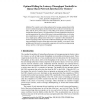Free Online Productivity Tools
i2Speak
i2Symbol
i2OCR
iTex2Img
iWeb2Print
iWeb2Shot
i2Type
iPdf2Split
iPdf2Merge
i2Bopomofo
i2Arabic
i2Style
i2Image
i2PDF
iLatex2Rtf
Sci2ools
EUROPAR
2001
Springer
2001
Springer
Optimal Polling for Latency-Throughput Tradeoffs in Queue-Based Network Interfaces for Clusters
We consider a networking subsystem for message–passing clusters that uses two unidirectional queues for data transfers between the network interface card (NIC) and the lower protocol layers, with polling as the primary mechanism for reading dataoff these queues. We suggest that for accurate mathematical analysis of such an organization, the values of the system’s states probabilities have to be taken into consideration, in addition to the well–known mean–value estimates. A single server single queue polling system with server’s “vacations” is then articulated via an M/G/1 queueing model. We present a method for obtaining the values of system’s states probabilities in such a scheme that can be used to identify “sweet spots” of the polling period that result in a reasonable compromise between the message passing latency and the overall system’s throughput.
| Added | 28 Jul 2010 |
| Updated | 28 Jul 2010 |
| Type | Conference |
| Year | 2001 |
| Where | EUROPAR |
| Authors | Dmitry Ponomarev, Kanad Ghose, Eugeny Saksonov |
Comments (0)

